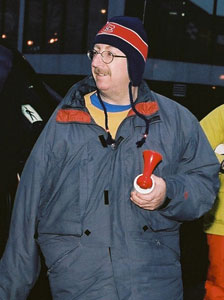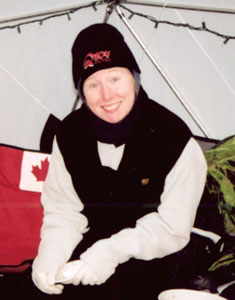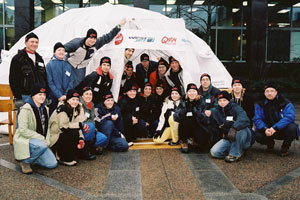 | ||
| Bruce Fowler helped to kick off the challenge at the opening ceremonies. He works at AV���ֲ�'s Personnel Services through New Leaf Enterprises, a program of the Abilities Foundation.ÊPhoto Credit: Findlay Muir | ||
But all good things must come to an end and I had lost my challenge - the dreaded potato sack race - to Toby Keeping, who later ended up placing second overall. As I shuffled across the finish line, my lungs screaming in pain, I could see Toby was waiting for me. He reached out and gave me a big hug. "Are you hurting as much as I am?" he asked. All I could do was nod. But I had made it — 17 out of 24 hours in the Q104-Easter Seals 24 Hour Relay Igloo Challenge. I was thrilled — and then promptly ran to the nearest garbage can and got sick.Ê
As we all made our way to Sackville Landing the prior morning for the competition, each participant was wondering just what kind of situation we were getting ourselves into. As we set up our gear in the igloo, we all looked apprehensively at each other. You could see each person asking themselves, "Am I doing the right thing?"
Within our first few igloo minutes, it was apparent that a sense of community was quickly developing. We were all in it together. Everything was going to be fine. Witnessing a courageous Eric Savage don a bathing suit during the initial challenge only brought us closer.
"When the first competitor was sent packing there was a sense of relief. No one wanted to be the first one headed home. Still, with every elimination thereafter, as someone else made their way down our makeshift walk of shame, there was an increasing feeling of sadness. These were all great competitors and even greater people. As they left, you were happy to still be in the game, but sad that you didn't get to know them a little bit better," reminisces contestant Harold Cook, of the Tall Ships Trading Company. "Though we battled one another, competition was set aside between events." Downtime was a chance to relax, and just get to know fellow contestants. Family, friends, co-workers, and even pets stopped by to offer support.
 | ||
| Holly Brown, of Communications and Marketing, lasted 17 of 24 hours as a contestant. Photo Credit: Findlay Muir | ||
All in all, it was pretty amazing to witness the evolution of the igloo gang, from the shy first hour to the end, where there was a fierce determination among the final few contestants. They had almost made it , in the bitterly cold early morning hours, and they each wanted that trip. Unfortunately, Jen Whalen couldn't buy a bounce in the penguin toss. Harold Cook's legs couldn't hold up leaning against the Daily News building. Even the intrepid Toby Keeping couldn't withstand the ultimate survivor Kurt Sampson in the scavenger hunt.
It was over.
It was fun.
It was darn cold.
After many hours of sleep and several hot baths, from the safety of a warm office, I reflected on lessons learned from the challenge:
1. Accept winter
Reading The Daily News during a rest period, a phrase caught my eye: "There's an old Swedish saying that there is no such thing as bad weather, only bad clothing." Boy, did they have that right! The article highlighted a recent conference, "Welcoming Winter: Changing the Climate of Planning," sponsored by the Faculty of Architecture and Planning. Living outside, with very little shelter, made us acutely aware that dressing properly was key to winter survival. Once this was taken care of, it became the key to winter fun!
2. Value teamwork
Before the competition,. I had an opportunity to speak with Carolyn Savoy, head coach of the women's basketball Tigers and associate professor in the Faculty of Health Professions. We discussed not only how to be a good leader but how to be a good team member. I used her suggestions about good team communication and reciprocal encouragement during the challenges where I was a spectator.Ê
I noticed that the more people cheered out support, the more energy the people competing had. I too felt the impact in my own challenges. Every time a person gave me even the smallest cheer of encouragement, I immediately had extra energy and thought that maybe I could go on, even though I didn't feel like I could. I noticed the same effect when several co-workers came to visit me. My confidence was immeasurably boosted by their simple act of support.
 | ||
| Everyone got into the spirit for 24 hours to raise awareness for the Easter Seals 24 Hour Relay in support of the Abilities Foundation of Nova Scotia. Photo Credit: Findlay Muir | ||
3. Catch the spirit of volunteering
When you volunteer, you not only give a part of yourself, but you also gain parts from all the people whose lives you touch.
In addition to myself, there was a strong contingent from the university: Pat McGrath, from Athletics and Recreation Services; Norma Melanson, a second-year nursing student from Portland, Maine; and Kurt Sampson, of Academic Computing Services. In addition to the engineering students who built the geodesic dome, all helped to round out a strong Dal community presence.
Everyone who participated had a constant grin on their face. I commented that I was smiling so much that my face was beginning to get sore. The spirit was contagious.
Ultimately, we were all outside for 24 hours to raise awareness for the Easter Seals 24 Hour Relay in support of the Abilities Foundation of Nova Scotia. The Abilities Foundation enables Nova Scotians with physical disabilities to enhance their quality of life by realizing their individual potential. Bruce Fowler helped kick off the challenge at the opening ceremonies. He works at AV���ֲ�'s Personnel Services through New Leaf Enterprises, a program of the Abilities Foundation.Ê Anyone who is interested in forming a new team for the Easter Seals 24 Hour Relay, please e-mail me at holly.brown@dal.ca. For more information about the Relay itself go to
